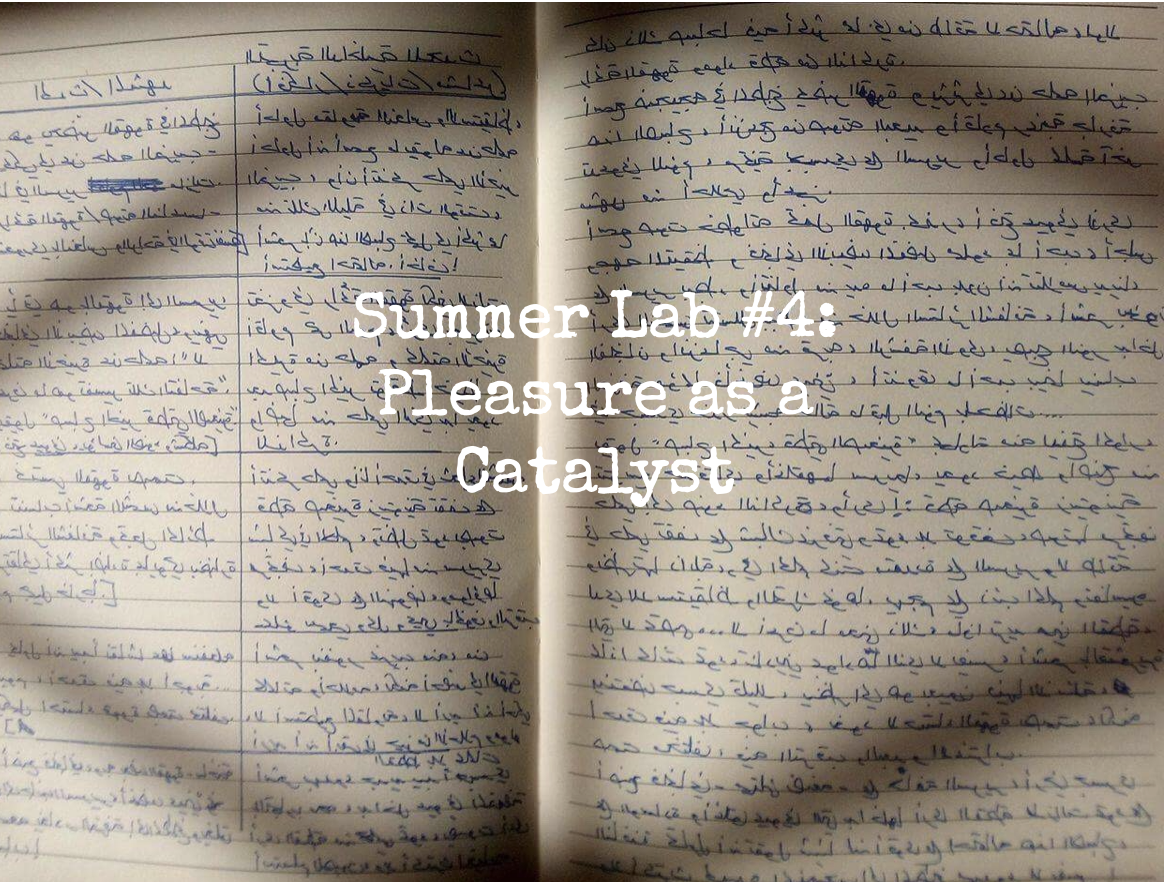image: sense writing sequence from a workshop in the west bank. used by permission.
In the last few weeks, I’ve been sharing with you a realization that feels essential, but which often becomes easy to overlook, especially when we get overwhelmed:
Regular life and creative life have different needs.
Once we’re actually able to make this distinction, it becomes possible to identify the needs of a creative life — and to develop tools to tend to those needs with clarity and care.
To develop those tools, we need a container for them. We need a kind of laboratory in which inquiry, exploration, and mistakes allow us to listen to our ache to create, and to ourselves, and to respond freely.
In this Summer Lab series, I’ve talked about some of the creative tools we cultivate in the laboratory: urges, textured exploration, insight, playfulness, mistakes. It’s an organic, layered discovery based on curiosity and pleasure.
But there’s something else that connects pleasure and the creative tools we use to engage with it. A missing link.
For pleasure to be meaningful — to be motivating, rather than simply distractingly pleasant — there has to be something concrete to show up to. A practice.
That missing piece is rigor.
The Infinite Loop of Rigor and Pleasure
I love rigor. Maybe it’s my background in dance — which known for requiring a rigorous practice before almost anything else — or maybe it’s all the science experiments (bought with my babysitting money) I carried out on the ping-pong table in the basement— but rigor has often felt welcoming to me.
I've had experiences where rigor could feel punishing and sharp and imposed, but mostly it's felt like a safety net rather than a confinement.
It was that experience of rigor that helped me identify my creative needs, and to leave my artistic communities in New York in search of tools to better address them. As a writer, it led me back to the body.
This longing for rigor led me to spend hundreds of hours on the floor in a Feldenkrais training exploring neurosensory exercises, and years making the connections between the way the nervous system learns and heals and the way we write and create.
The way I experience it, rigor doesn’t entail rigid “intestinal fortitude,” as my dad used to say, or tight-lipped discipline or virtue. Instead, rigor motivated by pleasure and curiosity, in the container of a creative laboratory, becomes self-sustaining. It opens up the pathway to true freedom and discovery.
Because at the heart of creative exploration is risk, and it can be scary. So we need a lab, a container for tat process, to be supported and safe as we venture into it.
Motivating that process is pleasure, and supporting it is rigor. We need both to sustain it.
And when those pieces of curious, playful exploration and contained practice come together, we get a creative process that we don’t have to fight or force — we just get to use it. For whatever we want, forever.
If you're curious to read some reflections on what happens when this relationship between pleasure and rigor is nurtured in creative practice, you can read hear from participants in the Sense Writing Course below.
And to explore this relationship yourself, you can try the recorded gift sequence below (What a Baby Can Teach Us about Writing). All you need is a notebook and a place to lie down!
“Madelyn’s Sense Writing process does its work invisibly: I can’t pinpoint when a shift happened. I know only that I experience more freedom and less self-judgment when drafting (and revising) my writing. The content is more fluid and voluminous because my inner critical voice has surrendered to not knowing, to not efforting. I’ve become kinder to my evolving writer self, recognizing and respecting the whole-body nature of creativity, trusting my nonverbal wisdom to collaborate with, even lead, my verbal sense.”
-Marj Hahne, writer and editor
“It’s hard for me to think of Sense Writing as “a course”, in any traditional sense. I experienced it more as a gentle but firm suggestion to fully inhabit our own selves, instead; our own bodies, our own felt knowledge and hard-earned authority, and therefore our own stories, as well. A most needed reminder, and reassurance, that the best stuff comes from the most basic and authentic place of self-occupancy. And rather than learning the material in any way that we’ve usually been taught, the exercises seep slowly into your subconscious, kindly re-arrange neuronal circuits, and then settle in as a constant vote of confidence that, at our core, we each already have with us everything that we need. (To write, yes, but also just to be; to do life, in exactly the way that each individual organism does best, anyway.)
Since working through the course, every time I feel the familiar daunt of the writing project that I am hoping to complete, I also hear the usual opposing whisper, but now lifted into a full clear voice: ‘Just do yourself. Be in your true self, observe from your most authentic place, and it will come.’ And whenever I lose hold of that most important place, I now have a specific set of tools to get back there.”
-Marti Maree, designer



